[OS] Process Concept
일부 내용은 시험에서 제외됨 (시험기간 직전에 알려줌)
Chapter 3: Process Concept
- Process Concept
- Process Scheduling
- Operation on Processes
- Inter-process Communication
- Examples of IPC Systems
- Communication in Client-Server Systems
Process Concept
- An operating system executes a variety of programs:
- Batch system – jobs
- Time-shared systems – user programs or tasks
- Textbook uses the terms job and process almost interchangeably.
- Process – a program in execution; process execution must progress in sequential fashion.
- A process includes:
- Resources: timers, pending signals, open files, network connections, hardware, and IPC mechanisms
- state, and a virtualized processor
The Multiple Parts (section) of a Process
- Each process has following memory sections
- Text section
- The program code(기계어로 번역된) & read-only data such as constant variables
- Current activity including program counter, processor registers
- Stack section containing temporary data
- Function parameters, return addresses, local variables
- Data section containing global variables
- 함수 밖에서 선언된 변수, static 변수
- Heap section containing memory dynamically allocated during run time
- Text section
Process in Memory
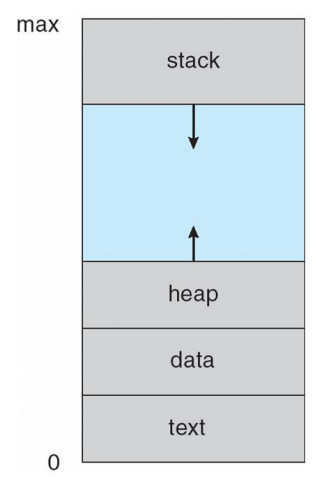
- program definition에서 하나의 process가 만들어진 모습 - process 주소 공간
- process 마다 만들어 지는 것! (protection 가능)
- text(code)는 program definition이 들어있는데 이를 그대로 탑재 - read only
- 그러나 모두 다 탑재하는 것은 비효율적이기 때문에 여러 process가 공유한다.
- data: 함수 밖에서 선언한 변수가 저장되는 공간 or static 변수
- stack: local 함수 변수
- heap: 동적 메모리 할당
유일하게 공유되는 부분은 text 부분!
다른 프로세스의 정보를 읽거나 수정하기 위해서는 커뮤니케이션이 이루어져야 함.(MPP or Shared memory)
Process Concept
- Program is passive entity stored on disk (executable file), process is active
- Program becomes process when executable file loaded into memory
- Execution of program started via GUI mouse clicks, command line entry of its name, etc
- One program can be several processes
- Consider multiple users executing the same program
Process State
- As a process executes, it changes state
- new: The process is being created.
- running: Instructions are being executed.
- waiting: The process is waiting for some event to occur.
- I/O completion, Signal
- ready: The process is waiting to be assigned to a process.
- terminated: The process has finished execution.
Diagram of Process State
매우 중요한 그림과 설명
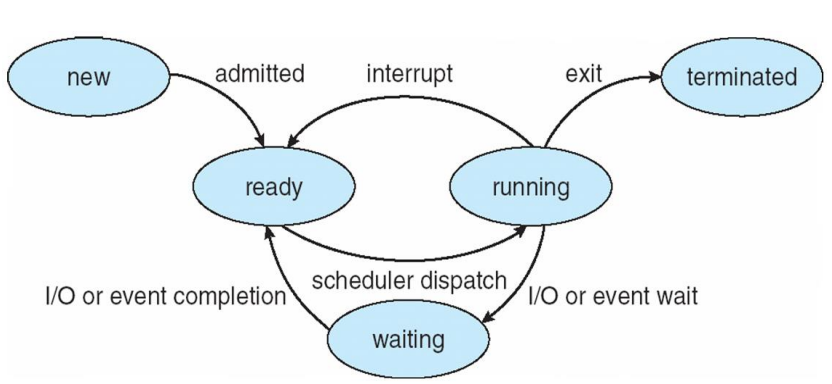
- new: process 주소 공간을 만듬(할당)
- PCB도 만듦.
- ready: 탑재가 종료되면 admitted 되어 CPU를 할당 받아야 하는데 다른 실행되어야 하는 프로그램들도 있기 때문에 줄(queue)을 서야 한다.
- 갯수 제한이 없음
- running으로 가는 걸 결정하는 것: short term scheduler
- running: CPU scheduling or priority
- 오로지 하나의 process만 가능(core가 하나이기 때문에)
- 프로세스가 interrupt가 걸린 경우 ready queue로 이동하게 됨
- waiting: I/O 혹은 event wait을 하는 경우, waiting을 하고나서 바로 실행 불가(다른 프로그램이 기다리고 있기 때문),
- 갯수 제한이 없음
- resume을 기다림
- event: read, printf, sleep, recv
- terminated: 모든 자원 반납(process 주소공간, 무수히 많은 자원)
- exit() 호출
- 마지막 문장 실행
Process Control Block (PCB)
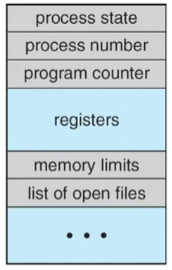
Information associated with each process.
-
new state에서 만들어짐
- Process state – running, waiting, etc
- Program counter – location of instruction to next execute
- CPU registers – contents of all process-centric registers
- CPU scheduling information
- Priority, pointers to scheduling queues
- Memory-management information
- memory allocated to the process
- Value of base, limit registers, page table
- Accounting information - CPU used, clock time elapsed since start, time limits
- I/O status information
- I/O devices allocated to process, list of open files
- 저장을 하는 이유: process가 running 상태에 있다가 다른 상태에 가고나서 다시 돌아올 때 실행을 잠시 중단 했던 시점의 snapshot 정보(original)를 복원하기 위한 목적
CPU Switch From Process to Process
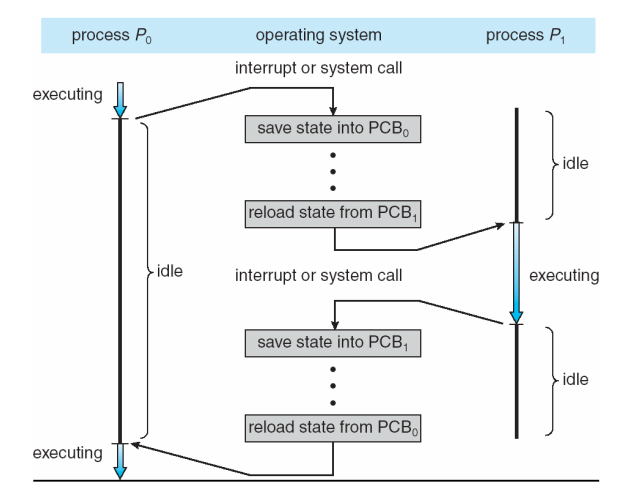
- P0가 실행되다가 interrupt나 system call을 실행한 경우 PCB0에 해당 프로세스와 관련된 정보를 모두 저장한다.
- ready state에 있던 process 중 P1이 실행을 시작한다.
- 시작하면서 PCB1에 저장되었던 process 정보를 복원한다.
- idle -> suspend
- executing -> resume
- suspend 되는 시점에서의 정보 -> running snapshot을 PCB에 저장
- 이 중 상당부분은 context switching overhead 때문에 사용되지 못함.
- 이 overhead를 해결하기 위해 나온 개념이 thread
Threads
- So far, process has a single thread of execution
- Consider having multiple program counters per process
- Multiple locations can execute at once
- Multiple threads of control -> threads
- Multiple locations can execute at once
- Must then have storage for thread details, multiple program counters in PCB
- See next chapter
- 어떤 프로그램에 프로그램 궤적이 여러 개가 있다면??
- 이 각각의 궤적을 thread라고 부른다!!
Process Representation in Linux
- Represented by the C structure
// task_struct
pid t pid; /* process identifier */
long state; /* state of the process */
unsigned int time slice /* scheduling information */
struct task struct *parent; /* this process’s parent */
struct list head children; /* this process’s children */
struct files struct *files; /* list of open files */
struct mm struct *mm; /* address space of this pro */
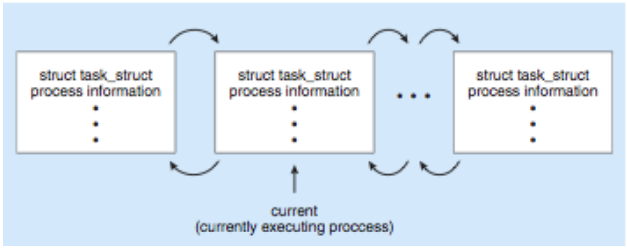
Process Scheduling
- Maximize CPU use, quickly switch processes onto CPU for time sharing 시험
- Process scheduler selects among available processes for next execution on CPU
- Maintains scheduling queues of processes
- Job queue – set of all processes in the system
- HDD에서 main memory로 탑재를 기다리는 프로그램들의 줄
- Ready queue – set of all processes residing in main memory, ready and waiting to execute
- Device queues – set of processes waiting for an I/O device
- Processes migrate among the various queues
- Job queue – set of all processes in the system
Ready Queue And Various I/O Device Queues
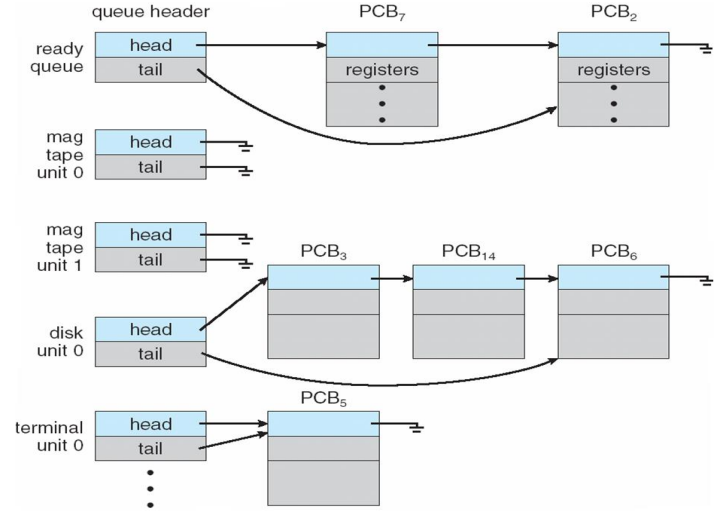
Representation of Process Scheduling
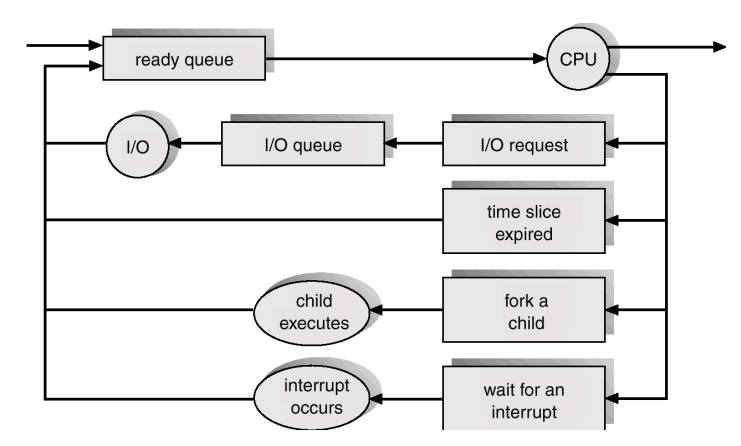
Schedulers
- Long-term scheduler (or job scheduler)
- selects which processes should be brought into the ready queue.
- Long-term scheduler is invoked infrequently (seconds, minutes) => (may be slow)
- The long-term scheduler controls the degree of multiprogramming (시험)
- If too many jobs with a lot of I/O,
- CPU utilization may be low,
- processes mainly blocked
- If too many jobs which are mainly computation
- Low utilization of I/O devices
- 그래서 I/O와 CPU 사용을 적절히 융화하는 것이 long tern scheduler의 일
- If too many jobs with a lot of I/O,
- Processes can be described as either:
- I/O-bound process(I/O를 많이 하는 process) – spends more time doing I/O than computations, many short CPU bursts.
- CPU-bound process(CPU 사용을 많이 하는 process) – spends more time doing computations; few very long CPU bursts.
- Long-term scheduler strives for good process mix
- Short-term scheduler (or CPU scheduler)
- selects which ready process should be executed next and allocates CPU (시험)
- Sometimes the only scheduler in a system
- Short-term scheduler is invoked very frequently (milliseconds)
- => (must be fast).
- multi-programming 환경이기 때문에 매우 빈번하게 실행됨.
Addition of Medium Term Scheduling
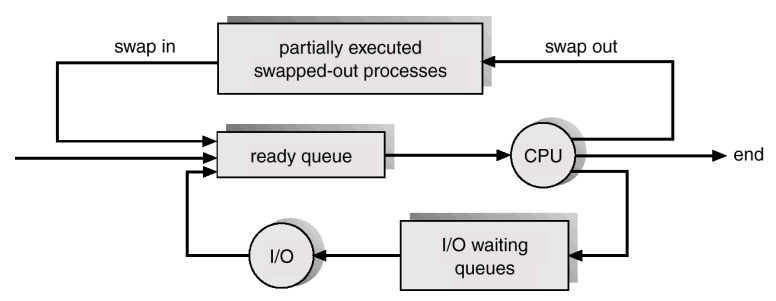
-
swap 하는 기능이 추가됨
-
부분적으로 실행되는 process를 하드디스크로 보내버림
- Medium-term scheduler can be added if degree of multiple programming needs to decrease
- degree of multiple programming이 높으면 throughput이 좋아지지만 너무 많아지면 오히려 낮아지는데 context switching overhead 가 너무 자주 일어나기 때문이다
- So, Sometimes system load needs to be readjusted
- Remove process from memory, store on disk, bring back in from disk to continue execution: swapping
- degree of multiple programming이 높으면 throughput이 좋아지지만 너무 많아지면 오히려 낮아지는데 context switching overhead 가 너무 자주 일어나기 때문이다
-
Some systems do not have
- 시스템 load가 줄어들 때까지 메모리에서 프로세스를 harddisk에 저장을 하고 죽인다.
Multitasking in Mobile Systems
- Some mobile systems (e.g., early version of iOS) allow only one process to run, others suspended
- Due to screen real estate, user interface limits iOS provides for a
- Single foreground process- controlled via user interface(ui)
- Multiple background processes– in memory, running, but not on the display, and with limits
- Limits include single, short task, receiving notification of events, specific long-running tasks like audio playback
- Android runs foreground and background, with fewer limits
- Background process uses a service to perform tasks
- Service can keep running even if background process is suspended
- Service has no user interface, small memory use
Context Switch
- When CPU switches to another process, the system must 1) save the state of the old process and 2) load the saved state for the new process via a context switch & 3) restart new process
- Context of a process represented in the PCB
- Context-switch time is overhead; the system does no useful work while switching
- The more complex the OS and the PCB -> the longer the context switch
- Time dependent on hardware support
- Some hardware provides multiple sets of registers per CPU -> multiple contexts loaded at once
Operations on Processes(매우 중요)
- System must provide mechanisms for
- process creation,
- Process termination,
- and so on as detailed next
Process Creation
- Parent process create children processes, which, in turn create other processes, forming a tree of processes
- Generally, process identified and managed via a process identifier (pid)
- Resource sharing options - design issue
- Parent and children share all resources.
- 부모 자식 간은 모든 자원을 공유한다.
- Children share subset of parent’s resources.
- Parent and child share no resources.
- Parent and children share all resources.
- Execution options
- Parent and children execute concurrently.
- Parent waits until children terminate
- 모든 프로세스는 init process의 자손이다.
A tree of Processes in Linux
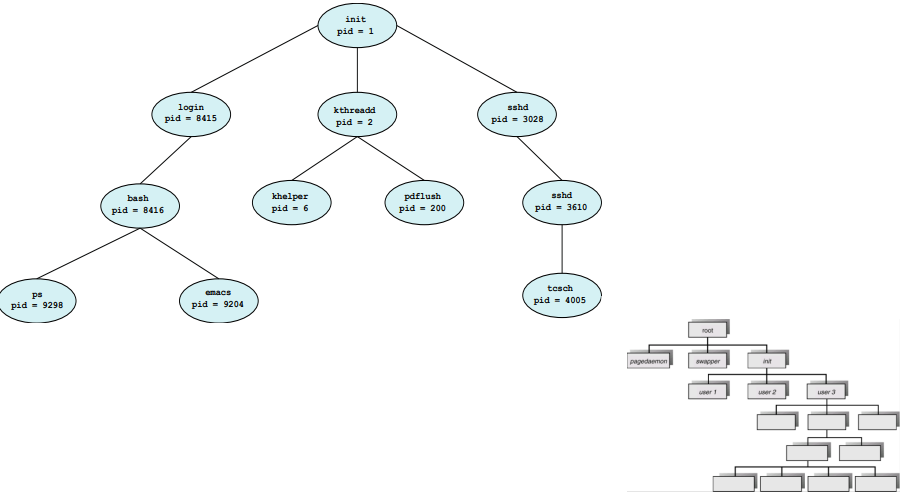
Process Creation (Cont.)
- Address space
- Child duplicate of parent.
- Child has a program(new program) loaded into it.
- UNIX examples
- fork system call creates new process
- exec system call used after a fork to
replace the process’ memory space with a new program.- 프로세스의 메모리 공간을 새로운 프로그램으로 대치한다.
- m = fork()
- m값은 parent도 받고 child도 받는데 그 값은 다르다.
- child한테는 0을, parent 한테는 child의 pid
- m값은 parent도 받고 child도 받는데 그 값은 다르다.
if (fork() != 0) /* parent code */
{ code to be executed by parent}
else
{ exec(code image) }

C Program Forking Separate Process
#include <sys/types.h>
#include <studio.h>
#include <unistd.h>
int main() {
pid_t pid;
/* fork another process */
pid = fork(); // thread control이 두 개가 됨
if (pid < 0) { /* error occurred */
fprintf(stderr, "Fork Failed");
return 1;
}
else if (pid == 0) { /* child process */
execlp("/bin/ls", "ls", NULL);
}
else { /* parent process */
/* parent will wait for the child */
wait (NULL);
printf ("Child Complete");
}
return 0;
}
Creating a Separate Process via Windows API
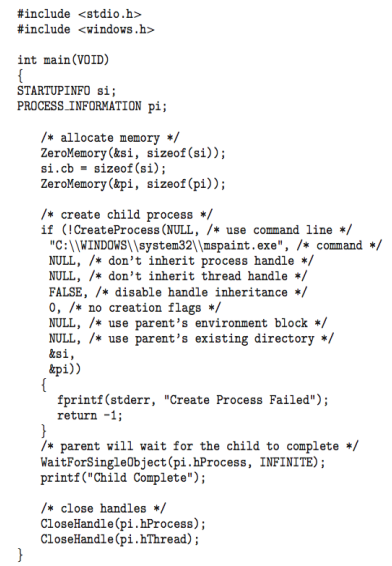
Process Creation (Cont.)
- Shell : process which is command interpreter
- Get command
- Execute command (fork a child, wait for a child to finish)
- Go back to get command
While (true) {
display prompt
read command (command, params)
if (fork() != 0) then{ wait(&status); exit() }
else { execve(command, parmas) }
shell이든 일반적인 프로그램에서 fork를 하든 동작원리는 같다.
Process Termination
- Process executes last statement and then asks the operating system to delete it using the exit() system call.
- Returns status data from child to parent (via wait())
- Process’ resources are deallocated by operating system
- Parent may terminate the execution of children processes using the abort() (비정상 종료)system call. Some reasons for doing so:
- abort()의 인자로 강제 종료 시킬 프로세스를 적는다.
- 다른 프로세스가 나를 종료시키려 할 때 쓰는 것이 abort
- Child has exceeded allocated resources
- Task assigned to child is no longer required
- The parent is exiting
- operating systems does not allow a child to continue if its parent terminates
- 부모 프로세스가 종료되면 그 아래 자손 프로세스들은 모두 종료된다.
- operating systems does not allow a child to continue if its parent terminates
- Some operating systems do not allow child to exists if its parent has terminated. If a process terminates, then all its children must also be terminated.
- cascading termination. All children, grandchildren, etc. are terminated.
- 모든 자손이 종료
- The termination is initiated by the operating system.
- cascading termination. All children, grandchildren, etc. are terminated.
- The parent process may wait for termination of a child process by using the wait() system call. The call returns status information and the pid of the terminated process
- pid = wait(&status);
- status: child process가 종료된 이유
- pid: 종료되어진 child process의 pid
- pid = wait(&status);
정상적인 방법으로 종료하지 못하는 프로세스(시험)
- If no parent waiting (did not invoke wait()) process is a zombie
- 만약 child process가 exit() 시스템콜로 종료했는데 parent process가 wait()으로 child process의 종료를 기다리지 않는 경우
- 이 때 종료되지 않은 child process를 zombie process라고 함.
- 만약 child process가 exit() 시스템 콜을 호출하여 종료했는데 parent process가 이를 wait()으로 child process의 종료를 기다리지 않으면 이때 이 child process는 zombie process가 된다.
- 이미 좀비 상태에서 kill 하면 명령어가 통하지 않는데, 부모 프로세스를 kill 함으로써?
- If parent terminated without invoking wait , process is an orphan(고아)
- parent가 wait()을 호출하지 않고 그냥 종료해 버린 경우
- wait()을 하지 않으면 parent가 자식이 종료되지 않았는데 그냥 종료되어 버릴 수 있는 것!
- parnet process가 child process가 아직 종료되지 않았는데 wait() 호출하지도 않고 그냥 종료되면 이때 child process는 orphan process가 된다.
정리
- 부모 프로세스가 자식 프로세스보다 먼저 종료되면 orphan process
- 자식 프로세스가 종료되었지만 부모 프로세스가 자식 프로세스의 종료를 회수하지 않는 경우 자식 프로세스는 zombie process
Multiprocess Architecture - Chrome Browser
- Many web browsers ran as single process (some still do)
- If one web site causes trouble, entire browser can hang or crash
- 한 사이트에 문제가 생긴 것이 다른 모든 사이트에 영향을 줌
- If one web site causes trouble, entire browser can hang or crash
- Google Chrome Browser is multiprocess with 3 categories
- Browser process manages user interface, disk and network I/O
- Renderer process renders web pages, deals with HTML, Javascript, new one for each website opened
- Runs in sandbox restricting disk and network I/O, minimizing effect of security exploits
- Sandbox: a virtual container in which untrusted programs can be safely run
- Plug-in process for each type of plug-in (ex: QuickTime….)

Interprocess Communication(IPC)
- Processes within a system may be independent or cooperating
- Independent process cannot affect or be affected by the execution of another process
- Cooperating process can affect or be affected by the execution of another process , including sharing data
- 공유데이터처럼 영향을 끼치거나 받는 프로세스
- Reasons for cooperating processes:
- Information sharing
- Computation speedup
- Modularity
- Convenience
- Cooperating processes need interprocess communication (IPC)
- Two models of IPC
- Shared memory
- Message passing
Communications Models
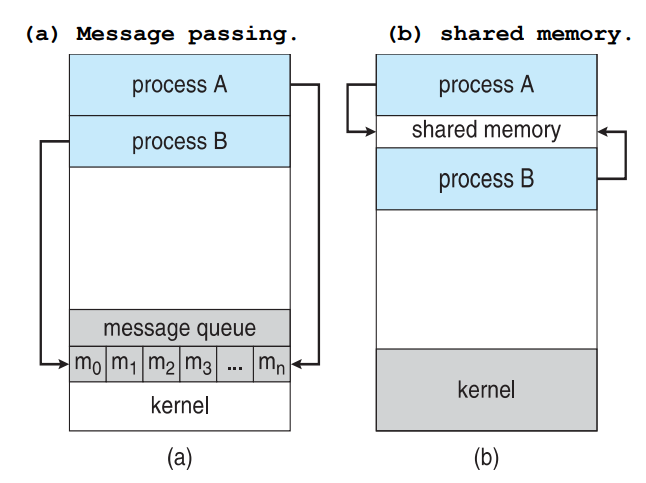
-
shared memory
-
process가 공유하는 메모리가 있음
-
shared memory가 만들어질 때는 OS의 도움을 받지만 그 이후는 OS의 도움을 받지 않는다.
-
-
MPP
- 메세지를 보낼 때마다 OS의 도움을 받는다.
- kernel에 메세지를 보내고 이를 읽고의 과정
- send
Producer-Consumer Problem (SM; shared memory)
example
- Paradigm for cooperating processes, producer process produces information that is consumed by a consumer process.
- unbounded-buffer places no practical limit on the size of the buffer.
- consumer may have to wait for new items, but the producer can always produce new items
- bounded-buffer assumes that there is a fixed buffer size.
- consumer must wait if the buffer is empty
- producer must wait if the buffer is full
- unbounded-buffer places no practical limit on the size of the buffer.
Bounded-Buffer - Shared-Memory Solution
- Shared data
#define BUFFER_SIZE 10
typedef struct {
. . .
} item;
item buffer[BUFFER_SIZE];
// 배열 slot의 index
int in = 0;
int out = 0;
- Solution is correct, but can only use BUFFER_SIZE-1 elements
- 버퍼에 저장할 공간이 실제로 하나가 남아있다 하더라도 이에 저장하게 되면 empty와 full을 구분할 수 없기 때문에 실제 버퍼 사이즈보다 하나 적게 사용가능하다.
Bounded-Buffer - Producer
item next_produced;
while (true) {
/* produce an item in next produced */
while (((in + 1) % BUFFER_SIZE) == out) // is buffer full?
; /* do nothing */
buffer[in] = next_produced;
in = (in + 1) % BUFFER_SIZE;
}
- in == out은 buffer가 비어있다는 것을 의미함.
- in과 out은 적어도 두 칸 이상 차이가 나야지 buffer에 내용을 넣을 수 있음.
Bounded Buffer - Consumer
item next_consumed;
while (true) {
while (in == out)
; /* do nothing */
next_consumed = buffer[out];
out = (out + 1) % BUFFER_SIZE;
/* consume the item in next consumed */
}
- in: 새로운 데이터를 쓸 위치
- out: consumer에서 데이터를 가져올(꺼내올) 위치
Interprocess Communication - Shared Memory
- An area of memory shared among the processes that wish to communicate
- The communication is under the
control of the user processesnot the operating system- OS가 아니라 user process의 control 하에 통신이 이루어짐
- Major issue is to provide mechanism that will allow the user processes synchronize their actions when they access shared memory.
- IPC using SM requires communicating processes to establish a region of shared memory
- shared memory resides in the address space of the process creating the shared memory segment
- Other processes that wish to communicate using this SM segment must attach it to their address space
Interprocess Communication – Message Passing
- Mechanism for processes to communicate and to synchronize their actions.
- processes communicate with each other without resorting(의지) to shared variables.
- Useful in a distributed environment
- Message passing facility provides two operations:
- send(message) - message size fixed or variable
- receive(message)
- The message size is either fixed or variable
- Using fixed-sized message, implementation of OS is simple, application programming is difficult
- Using variable-sized message, implementation of OS is complex, application programming is simple
- send(), receie()
Message Passing (Cont.)
- If P and Q wish to communicate, they need to:
- establish a communication link between them
- exchange messages via send/receive
- Implementation issues:
- How are links established?
- Can a link be associated with more than two processes?
- How many links can there be between every pair of communicating processes?
- What is the capacity of a link?
- Is the size of a message that the link can accommodate fixed or variable?
- Is a link unidirectional or bi-directional?
- Implementation of communication link
- Physical:
- Shared memory
- Hardware bus
- Network
- Logical:
- Direct or indirect (Naming)
- 수신자를 명확히 할 것인가 불명확히 할 것인가
- Symmetric or asymmetric communication (Symmetry)
- Synchronous or asynchronous (Synchronization)
- async - 상대방의 수신여부와 상관없이 막 보내는
- Automatic or explicit buffering (Buffering)
- Direct or indirect (Naming)
- Physical:
Naming Direct Communication
- Processes must name each other explicitly:
- send (P, message) - send a message to process P
- receive (Q, message) - receive a message from process Q
- Properties of communication link
- Links are established automatically.
- A link is associated with exactly one pair of communicating processes.
- Between each pair there exists exactly one link.
- The link may be unidirectional, but is usually bi-directional.

- Shared memory와 달리 message passing은 OS가 synchronize 문제를 책임지고 해결해야 함.
Direct Communication
- Exhibits symmetry in addressing
- Both the sender and the receiver processes must name the other to communicate
- A variant (Asymmetry)
- Only the sender names the recipient; recipient is not required to name the sender
- send (P, message) : send a message to process P
- receive(id, message) : receive a message from any process; id is set to the name of the process with which communication has taken place
- 어떤 프로세스가 보냈는지 해당 프로세스의 id가 담긴다.
Naming Indirect Communication
- Messages are directed and received from mailboxes (also referred to as ports).
- Send(A, msg), receive(A, msg)
- A는 pid가 아닌 mailbox의 ID
- Each mailbox has a unique id.
- A process can communicate with some other process via a number of different mail boxes
- Processes can communicate only if they share a mailbox.
- Send(A, msg), receive(A, msg)
- Properties of communication link
- Link established only if processes share a common mailbox
- A link may be associated with more than two processes.
- Each pair of processes may share several communication links.
- Link may be unidirectional or bi-directional.
프로세스가 메시지를 보내는데, 메시지를 받을 수신자를 따로 명시하지 않는다.
Indirect Communication (Continued)
- Operations
- create a new mailbox (port)
- send and receive messages through mailbox
- destroy a mailbox
- Primitives are defined as:
- send(A, message) – send a message to mailbox A
- receive(A, message) – receive a message from mailbox A
- Mailbox owned by process
- Mailbox is part of address space of the process
- Owner can only receive messages, user can only send messages
- Mailbox owned by kernel
- Mailbox is not attached(종속) to any particular process
- Ownership can be passed to other processes
- Operations of mailbox
- create a new mailbox (owner)
- send (owner) and receive (user) messages through mailbox
- destroy a mailbox
- Mailbox sharing
- P1 , P2 , and P3 share mailbox A.
- P1 , sends; P2 and P3 receive.
- Who gets the message?
- Solutions
- Allow a link to be associated with at most two processes.
- Allow only one process at a time to execute a receive operation.
- Allow the system to select arbitrarily the receiver. Sender is notified who the receiver was.
Synchronization
- Message passing may be either blocking or non-blocking.
- Blocking is considered synchronous
- Blocking send has the sender block(waiting) until the message is received
- 내가 원하는 프로세스가 메시지를 받을때까지 Block 되어 있는 것
- Blocking receive has the receiver block until a message is available
- 어떠한 메시지가 도착 할 때까지 Block 되어 있는 것
- Blocking send has the sender block(waiting) until the message is received
- Non-blocking is considered asynchronous
- Non-blocking send has the sender send the message and continue
- Non-blocking receive has the receiver receive a valid message or null message
- 메세지가 안 왔으면 그냥 널메세지를 받았다고 하고 리턴
- 제대로 수신이 되었는 지를 사용자가 확인해야 함.
- send and receive primitives may be either blocking or non-blocking.
- Blocking send
- Nonblocking send
- Blocking receive
- Nonblocking receive
- When both the send and receive are blocking -> rendezvous scheme(랑데뷰 sheme)
- end, receive 는 꼭 먼저 호출한 것이 끝나야 그 다음 것을 send or receive 할 수 있다.
- Producer-consumer becomes trivial
message next produced;
while (true) {
/* produce an item in next produced */
send(next produced);
}
message next consumed;
while (true) {
receive(next consumed);
/* consume the item in next consumed */
}
non-blocking의 경우 위 코드로 동작하지 않음 (자동으로 확인하여 기다리는(blocking) 기능이 있기 때문)
non blocking은 가득찼는지를 확인하는 코드를 부수적으로 요구
Buffering
- Queue of messages attached to the link; implemented in one of three ways.
-
Zero capacity – 0 messages Sender must wait for receiver (rendezvous, synchronous).
-
Bounded capacity – finite length of n messages Sender must wait if link full. (Asynchronous)
-
Unbounded capacity – infinite length Sender never waits.
| Process P | Process Q |
|---|---|
| Send(Q, msg) | receive(P, msg) |
| Receive(Q, msg) | send(P, ACK) |
Examples of IPC Systems - POSIX
- POSIX provides both of Message Passing and Shared Memory
- POSIX Shared Memory
- POSIX SM is organized using memory-mapped file, which associate the region of SM with a file
- Process first creates shared memory segment
shm_fd = shm_open(name, O CREAT | O RDRW, 0666);
- Also used to open an existing segment to share it
- Set the size of the object
ftruncate(shm_fd, 4096);
- Establish a memory-mapped file containg shared memory segment using
mmap( ) - Now the process could write to the shared memory
sprintf(shared memory, "Writing to shared memory");
- Process first creates shared memory segment
IPC POSIX Producer
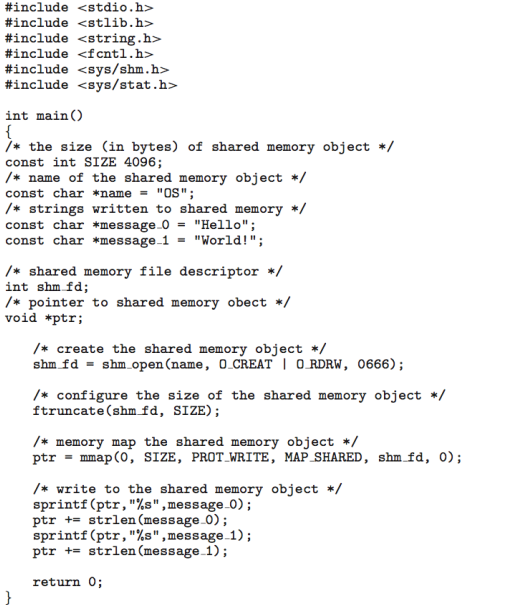
IPC POSIX Consumer
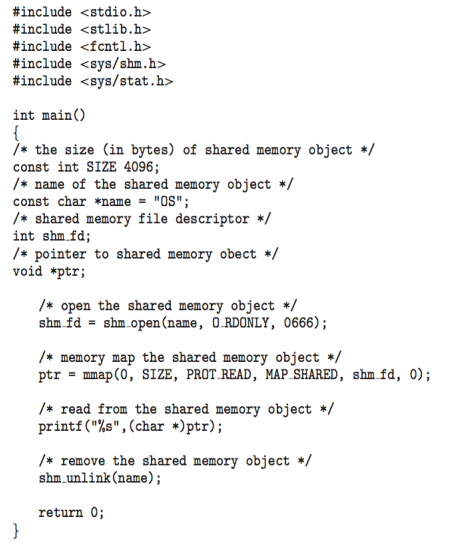
An example of IPC: Mach
MPP 예
-
Mach developed at CMU
-
Task : similar to multi-threaded-process
-
Most communication (system call or intertask information) is done by message using mailbox
- Even system calls are messages
- Each task gets two mailboxes at creation- Kernel and Notify
- Kernel mailbox: kernel communicate with task through this
- Notify mailbox : kernel sends notification of event occurrence
- Only three system calls needed for message transfer
msg_send(), msg_receive(),msg_rpc(): sends a message and waits for exactly one return message from the sender
- Mailboxes needed for commuication, created via
- port_allocate()
- Send and receive are flexible, for example four options if mailbox full:
- Wait indefinitely
- Wait at most n milliseconds
- Return immediately
- Temporarily cache a message
Examples of IPC Systems - Windows XP(생략)
- Message-passing centric via local procedure call (LPC) facility
- Only works between processes on the same system
- Uses ports (like mailboxes) to establish and maintain communication channels
- Communication works as follows:
- The client opens a handle to the subsystem’s connection port object.
- The client sends a connection request.
- The server creates two private communication ports and returns the handle to one of them to the client.
- The client and server use the corresponding port handle to send messages or callbacks and to listen for replies.
Local Procedure Calls in Windows XP(생략)

분산 어플리케이션의 예 client server model
Communications in Client-Server Systems
- Sockets – low level form of communication between distributed processes
- Remote Procedure Calls (RPC)
- Pipes
- Remote Method Invocation (Java)
Sockets
- A socket is defined as an endpoint for communication.
- Concatenation of IP address and port number
- The socket 161.25.19.8:1625 refers to port 1625 on host 161.25.19.8
- Communication consists between a pair of sockets.
- Three types of sockets
- Connection-oriented (TCP)
- Connectionless (UDP)
- MulticastSocket class– data can be sent to multiple recipients
- All ports below 1024 are well known, used for standard services
- Special IP address 127.0.0.1 (loopback) to refer to system on which process is running
Socket Communication
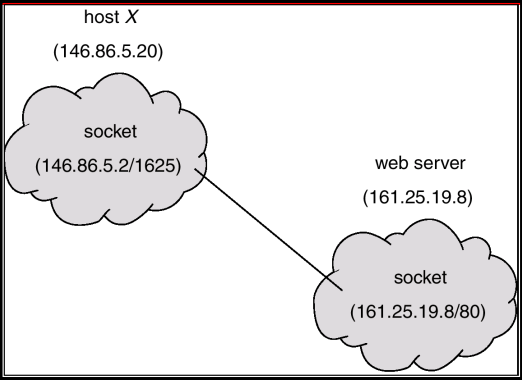
- Communication using socket is considered a low-level form of communication between distributed processes
- Socket allows only an unstructured stream of bytes to be exchanged
- It is the responsibility of server/client to impose a structure on the data
Date Client
public class DateClient {
public static void main(String[] args) {
try { // this could be changed to an IP name or address other than the localhost
Socket sock = new Socket("127.0.0.1",6013);
InputStream in = sock.getInputStream();
BufferedReader bin = new BufferedReader(new InputStreamReader(in));
String line;
while( (line = bin.readLine()) != null)
System.out.println(line);
sock.close();
}
catch (IOException ioe) {
System.err.println(ioe);
}
}
}
Date Server
public class DateServer{
public static void main(String[] args) {
try {
ServerSocket sock = new ServerSocket(6013); // now listen for connections
while (true) {
Socket client = sock.accept();
// we have a connection
PrintWriter pout = new PrintWriter(client.getOutputStream(), true);
// write the Date to the socket
pout.println(new java.util.Date().toString());
client.close();
}
}
catch (IOException ioe) {
System.err.println(ioe);
}
}
}
Remote Procedure Calls(RPC)
- Remote procedure call (RPC) abstracts procedure calls between processes on networked systems.
- Again uses ports for service differentiation
- Messages exchanged are well structured(unlikely port) and are not no longer just packets of data
- Each message is addressed to an RPC daemon listening to a port on the remote system
- RPC daemon이 계속해서 port를 들여다 봐서 메세지가 왔는지를 확인한다.
- Each message contains an id.
- Specifying the function to execute, and parameters
- The function is executed as requested, and any out is sent back in a separate message
- RPC message를 보낸 process에게 다시 응답.
-
Port – used to service differentiation
- Stubs – client-side proxy for the actual procedure on the server.
- 서버로부터 받은 메세지를 클라이언트 측에 가공해서 주는 역할
- RPC마다 하나씩 존재
- Separate stub for each separate remote procedure
- The client-side stub locates the server and marshalls(전송 format으로 바꿔주는 역할) the parameters.
- The server-side stub receives this message, unpacks the marshalled(local function 형태로 바꿈) parameters, and performs the procedure on the server.
- On Windows, stub code compile from specification written in Microsoft Interface Definition Language (MIDL)
-
Data representation handled via External Data Representation (XDL) format to account for different architectures
- Big-endian and little-endian (marshalling, unmarshalling)
-
Semantics of RPC
-
Remote communication has more failure scenarios than local
-
Messages can be delivered exactly once rather than at most once
- 정확히 한번을 보낼 수 있다.
-
- OS typically provides a rendezvous (or matchmaker) service to connect client and server
Execution of RPC
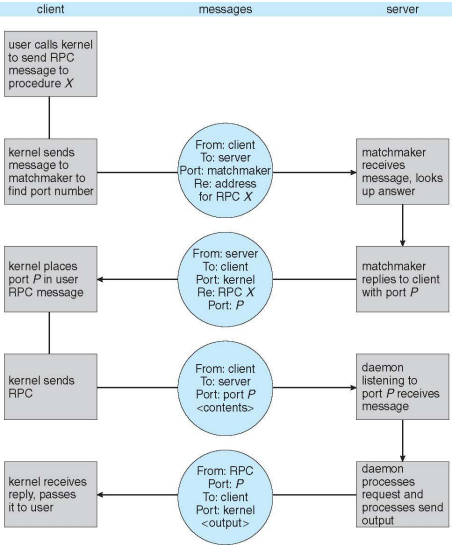
- client가 server 쪽의 함수를 호출하려고 하는 경우
- procedure X에게 RPC를 보내달라고 요구
- kernel에서 matchmaker에게 메세지를 보냄
- X라는 procedure의 port번호를 알려줘!
-
from: client to: server port: matchmaker
- matchmaker가 port P(RPC X)를 찾아서 kernel(사용자)에게 다시 보냄
-
from: server to: client port: kernel
-
- RPC의 포트번호를 알았으니 kernel은 RPC에게 메세지를 보낸다.
-
from: client to: server port: port P
-
- RPC daemon이 port를 listen하고 있다가 메세지가 오면 이를 받는다.
- daemon process가 X 함수를 실행한 결과를 message에 담아서 보내게 된다.
-
from: RPC to: client port: kernel
-
Pipes
- Acts as a conduit allowing two processes to communicate
- Issues
- Is communication unidirectional or bidirectional?
- In the case of two-way communication, is it half or full-duplex?
- Must there exist a relationship (i.e. parent-child) between the communicating processes?
- Can the pipes be used over a network?
- Ordinary pipes – cannot be accessed from outside the process that created it.
- Typically, a parent process creates a pipe and uses it to communicate with a child process that it created. (same machime)
- Named pipes – can be accessed without a parent-child relationship.
Ordinary Pipes(시험)
- Ordinary Pipes allow communication in standard producer-consumer style
- Producer writes to one end (the write-end of the pipe)
- Consumer reads from the other end (the read-end of the pipe)
- Ordinary pipes are therefore unidirectional
- If two way communication is required, two pipes must be used
- Require parent-child relationship between communicating processes
- Is used to communicate with a child process that it creates via fork()
- Windows calls these anonymous pipes
- See Unix and Windows code samples in textbook
Ordinary Pipes
Pipe ( int fd[] )
- Creates a pipe
- fd[0] is the read-end of pipe, fd[1] is write-end

Ordinary pipe in UNIX
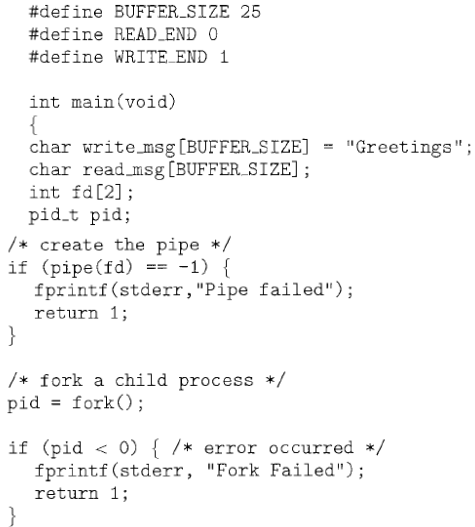
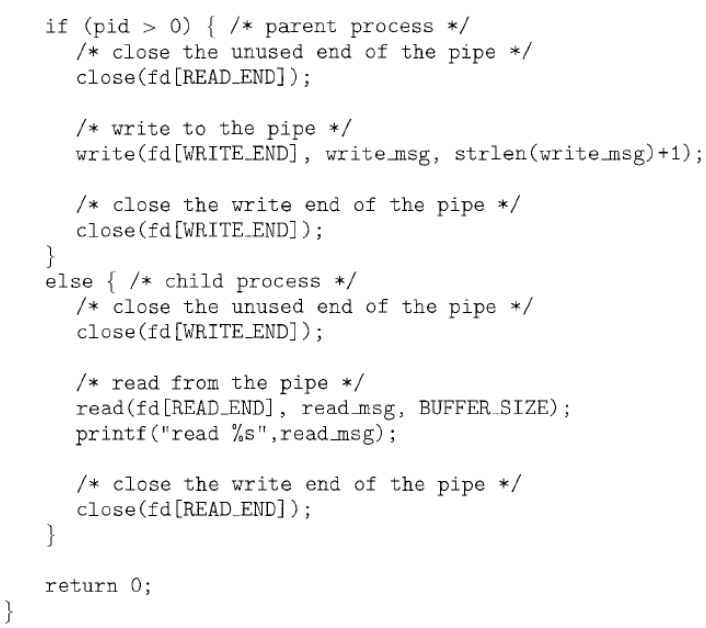
Named Pipes
- Named Pipes are more powerful than ordinary pipes
- Communication is bidirectional, half-duplex
- For full-diplex, two named pipes are required
- Can be used in a single machine
- No parent-child relationship is necessary between the communicating processes
- Several processes can use the named pipe for communication
- Provided on both UNIX and Windows systems
- Named Pipe of Window provides full duplex, intra or inter machine communication
- makefifo(), open(), read(), write(), close() for Unix
- CreateNamedPipe(), ConnectNamed Pipe(), ReadFile(), WriteFile()
Remote Method Invocation(RMI)
- Remote Method Invocation (RMI) is a Java mechanism similar to RPCs.
- RMI allows a Java program on one machine to invoke a method on a remote object.
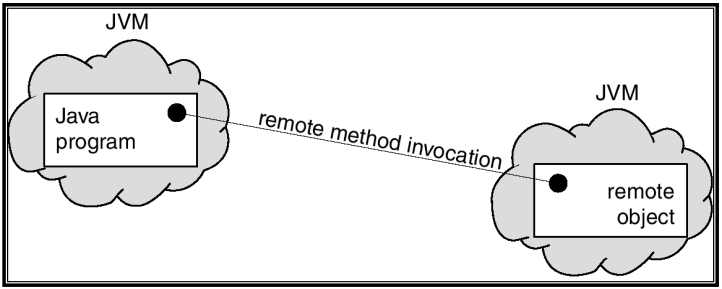
RPC vs. RMI
- RPC support procedural programming; only remote procedures or functions are called
- RMI is object-based; supports invocation of methods on remote objects
- Parameters to remote procedures are ordinary data structures in RPC
- Possible to pass objects as parameters to remote methods in RMI
Marshalling Parameters
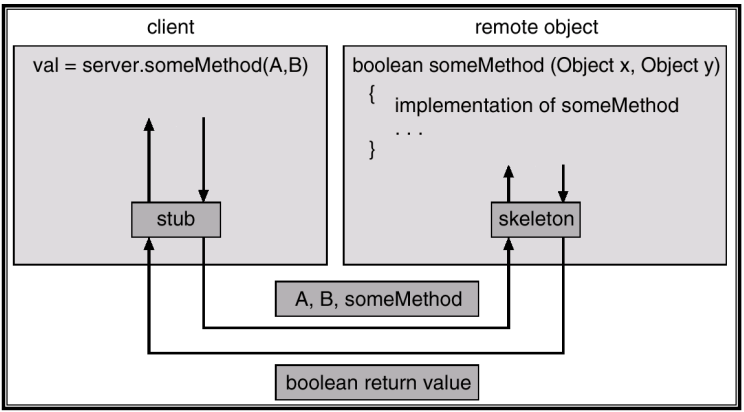
Concurrency
- Concurrency in Clients
- Clients can be run on a machine either iteratively (running them one by one) or
- Concurrently (more than two clients can run at the same time)
- Iterative running means
- Concurrency in Servers
- Iterative server
- Concurrent server
Connectionless iterative server

ephemeral: 일시적인
Connection-oriented concurrent server
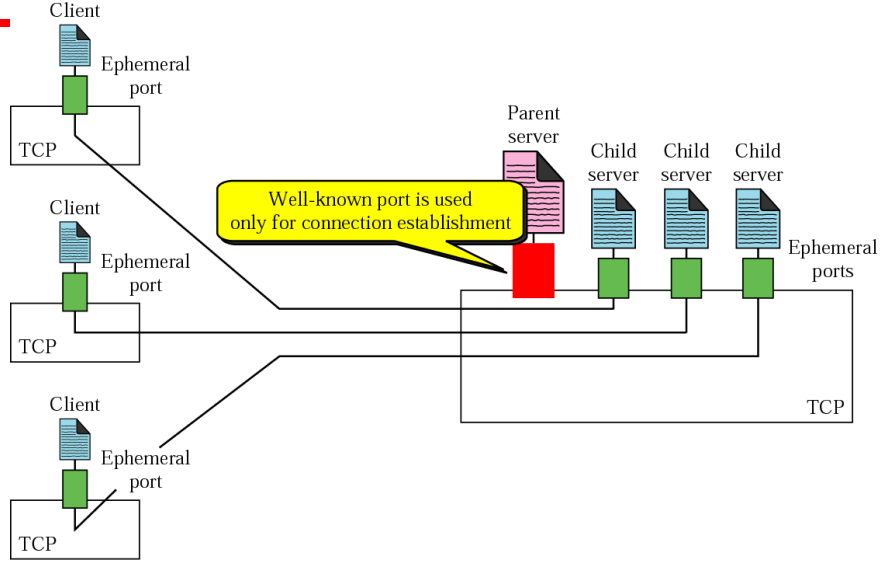
-
TCP 사용
-
child process는 well-known port가 필요없음
- well-known port는 서버에 접속 하는 데만 필요하기 때문에
Programs and processes
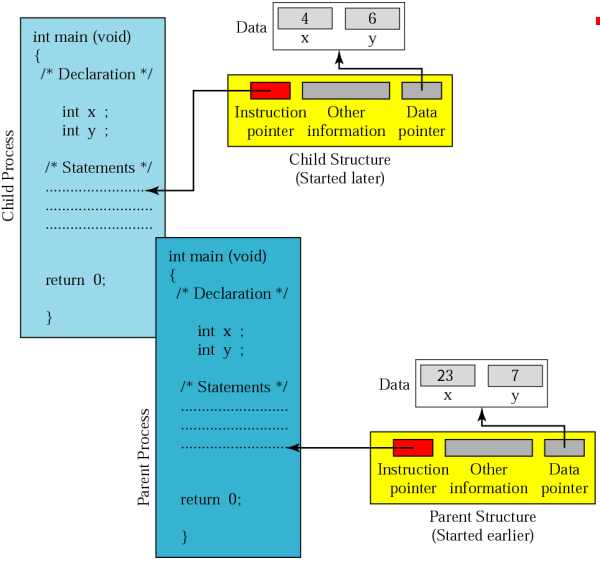
서로는 독립적인 process이기 때문에 정보를 공유하기 위해서는 IPC mechanism를 사용해야 함.
A Program that prints its own processid
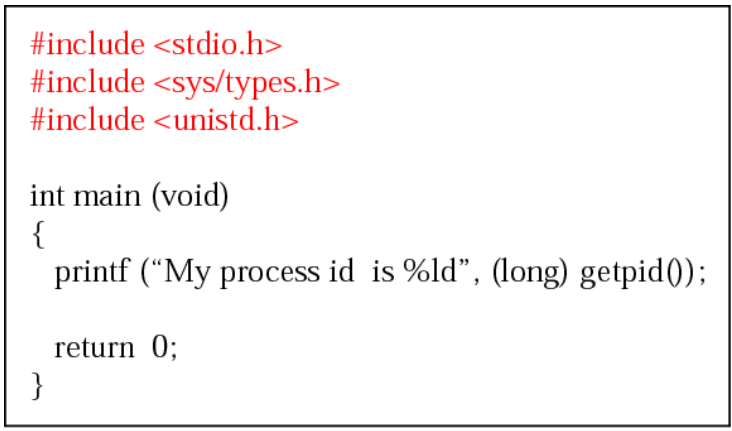
A program with one parent and one child
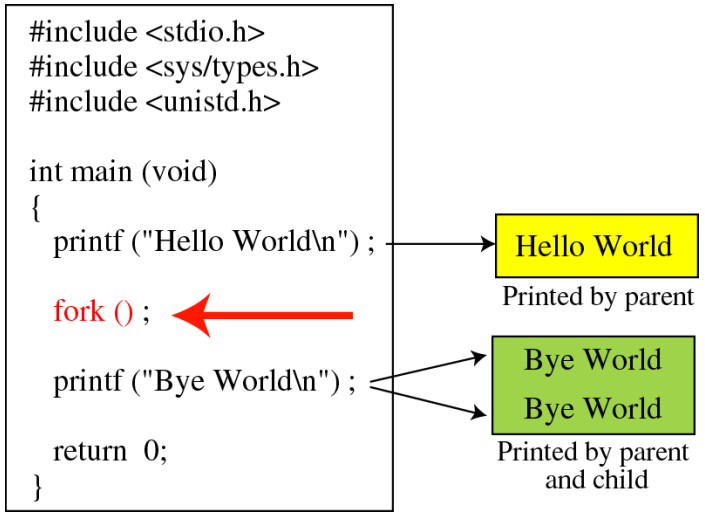
A program with two fork functions
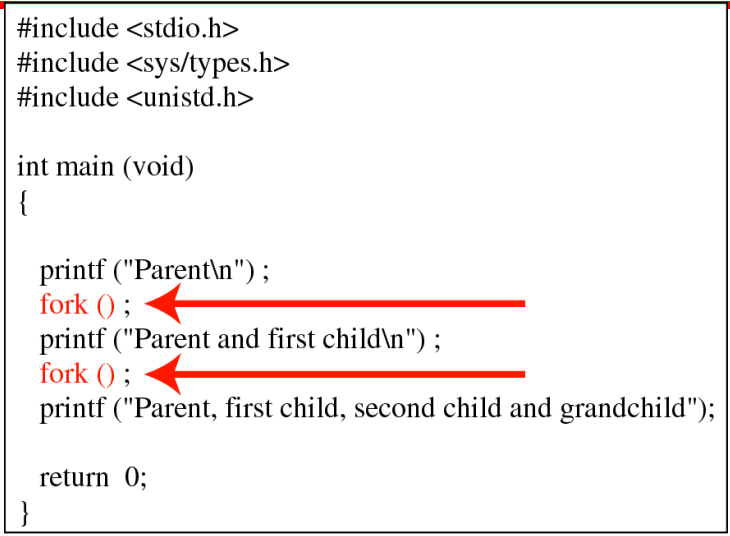
fork()를 한 번 하면 두 갈래가 되고 또 한번 fork()를 하면 각 갈래에서 두 갈래씩 나오기 때문에 총 4갈래로 나눠짐.
The output of the program in Figure 15.12
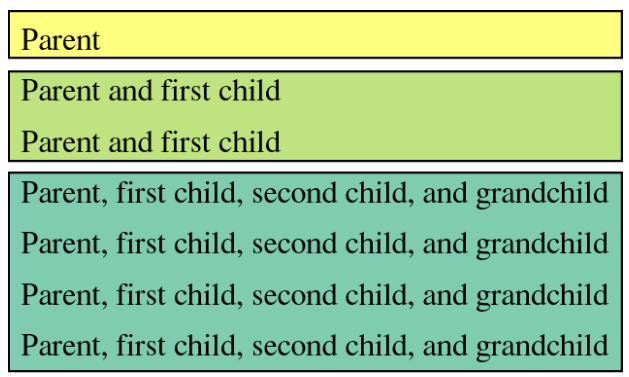
A program that prints the processids of the parent and the child

Example of a server program with parent and child processes
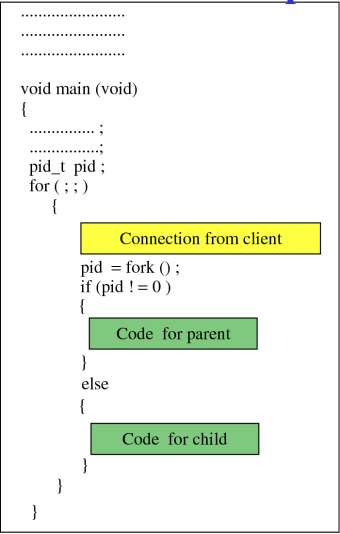
TCP 서버 함수 (1/8)
- TCP 서버 함수
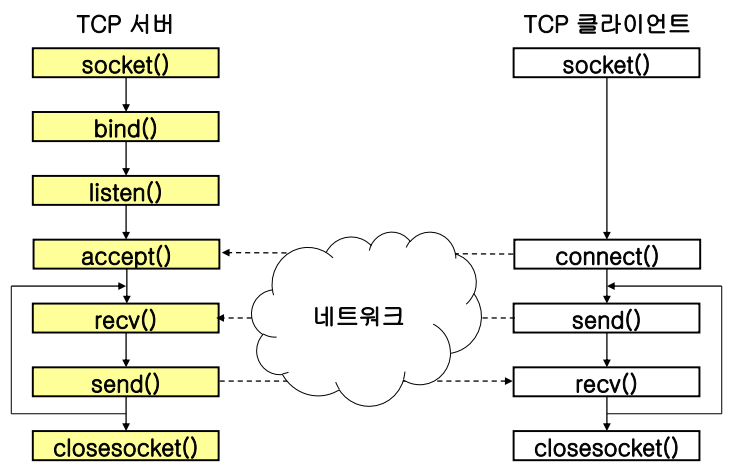
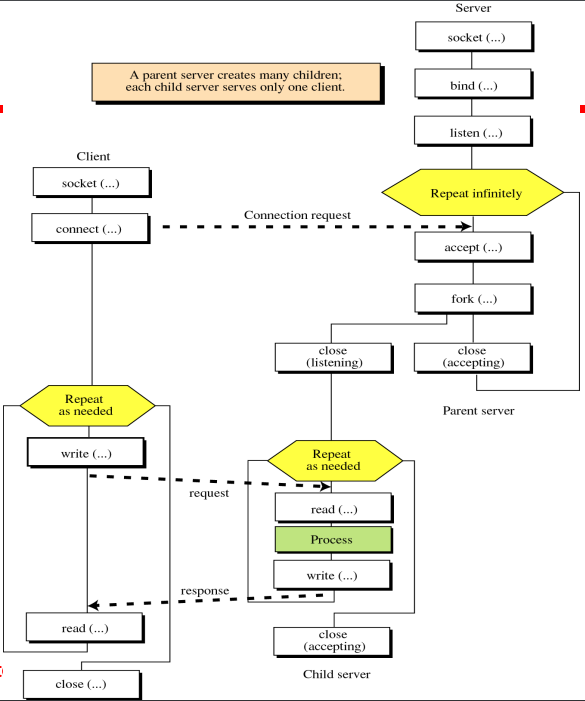

댓글남기기